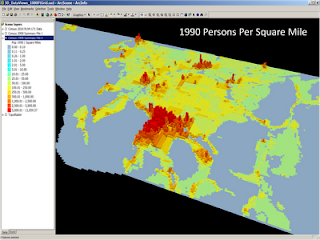 People who want to make money from land development are identifiable (we know who they are). Their interest is easy to quantify in the short term. They have a direct, immediate incentive to work for their goal. There is a limited number of them, which makes it easy and beneficial for them to get together in order to promote their mutual interests.
People who want to make money from land development are identifiable (we know who they are). Their interest is easy to quantify in the short term. They have a direct, immediate incentive to work for their goal. There is a limited number of them, which makes it easy and beneficial for them to get together in order to promote their mutual interests.The general public’s concern with “the environment,” on the other hand, is diffuse: we don’t know exactly who will benefit, or to what extent. An individual’s interest is difficult to quantify: what’s the “value” of breathing clean air? It has a value, but we have never quantified it. What’s the “value” of fish in the river versus fewer fish in the river (for those of us who don't fish for a living)? As a society, we have decided that a healthy salmon run has "value," but we don't know how much. Per capita.
Environmental costs and benefits are calculated in the long term. Lake Whatcom is fine to drink from right now, but who can credibly predict how much will it cost to drink from Lake Whatcom ten years from now? Or how that cost compares to the cost of an ounce of prevention?
The environment, quality of life, community – their “value” is, of course, immense. But on an individual basis, no person’s interest is necessarily greater than anyone else’s, so there’s no reason for any individual to invest time and effort. In fact, if I invest time and effort and nobody else puts in the time and effort, my time and effort are completely lost.
With apologies to John Kenneth Galbraith, whose Culture of Contentment is quoted below, this is how I explain the future of working in environmental and land use jobs to my students.
Bringing it home:
Our current County Council majority only supports short-term, identifiable, quantifiable individual interests.
The rest of us, and surely it is a majority, who care about the air that we breathe, the water that we drink, and the plants and animals that share the earth with us, can take one small step to preserve our modest stakes in the world.
We can, at least, vote.
Unfortunately, there is little evidence right now that our commitment runs that deep.
Carl Weimer made a rational decision when he decided not to run for County Executive. As much as many of us wanted him to run – to take on the burden of fighting our collective battles – the collective will and support that would allow him to succeed are not in evidence. And by "succeed," I don't just mean "get elected." I mean "do the job of which he is capable."
From John Kenneth Galbraith, The Culture of Contentment.
Subsidies “provide a significant benefit to a small number of people while distributing the costs of providing that benefit over the population as a whole. Thus, those receiving the subsidy have a strong incentive to see it maintained, and a commonality of interests that promotes collective action. Because their numbers are relatively small, the transaction costs of pooling their resources and coordinating their activities are small compared to the benefits of cooperating.
By comparison, each member of the general public shares an infinitesimal portion of the cost of the subsidy. The cost in time and resources of recouping this tiny loss far outweigh the actual return to the individual. Thus, individuals have little incentive to oppose the subsidy. As a result of general public inertia, then, the subsidy-seekers can maintain the subsidy indefinitely to the disadvantage of society as a whole.”

